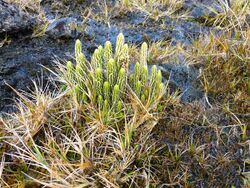Biology:Austrolycopodium magellanicum
| Austrolycopodium magellanicum | |
|---|---|

| |
| Scientific classification | |
| Kingdom: | Plantae |
| Clade: | Tracheophytes |
| Clade: | Lycophytes |
| Class: | Lycopodiopsida |
| Order: | Lycopodiales |
| Family: | Lycopodiaceae |
| Genus: | Austrolycopodium |
| Species: | A. magellanicum
|
| Binomial name | |
| Austrolycopodium magellanicum (P.Beauv.) Holub[1]
| |
| Synonyms[1] | |
| |
Austrolycopodium magellanicum, synonym Lycopodium magellanicum, the Magellanic clubmoss,[2] is a species of vascular plant in the club moss family Lycopodiaceae.[1] The genus Austrolycopodium is accepted in the Pteridophyte Phylogeny Group classification of 2016 (PPG I),[3] but not in other classifications which submerge the genus in Lycopodium.[4]
The species grows in the mountains of Latin America from Costa Rica and the Dominican Republic south as far as Tierra del Fuego, as well as a number of islands in the antarctic and subantarctic oceans (Tristan da Cunha, Gough Island, Amsterdam Island,[citation needed] South Georgia and the South Sandwich Islands, Falkland Islands, Juan Fernández Islands, Marion Island, Prince Edward Islands, Iles Crozet, Iles Kerguelen).[5]
A number of natural products have been isolated from this plant, including magellanine, magellaninone, panticuline, acetyldihydrolycopodine, acetylfawcettiine, clavolonine (8b-hydroxylycopodine), deacetylfawcettiine, fawcettiine, lycopodine, lycodine, alpha-obscurine (2,3-dihydro-b-obscurine), and beta-obscurine.[6] Some of the molecules within this class are known inhibitors of acetylcholinesterase (AChE).[7]
References
- ↑ 1.0 1.1 1.2 Hassler, Michael; Schmitt, Bernd (November 2019), "Austrolycopodium magellanicum", Checklist of Ferns and Lycophytes of the World, 8.11, https://worldplants.webarchiv.kit.edu/ferns/, retrieved 2019-12-05
- ↑ Burton, Robert; Croxall, John C. (2012). A Field Guide to the Wildlife of South Georgia. Princeton University Press. pp. 176. ISBN 9780691156613. https://books.google.com/books?id=jT8AAgAAQBAJ&pg=PA176.
- ↑ PPG I (2016). "A community-derived classification for extant lycophytes and ferns". Journal of Systematics and Evolution 54 (6): 563–603. doi:10.1111/jse.12229.
- ↑ Christenhusz, Maarten J.M.; Chase, Mark W. (2014). "Trends and concepts in fern classification". Annals of Botany 113 (9): 571–594. doi:10.1093/aob/mct299. PMID 24532607.
- ↑ "Family Lycopodiaceae, genus Lycopodium; world species list". http://homepages.caverock.net.nz/~bj/fern/lycopodium.htm.
- ↑ Isolation of Magellanine Canadian Journal of Chemistry, 1976, 54:(18) 2893-2899.
- ↑ Review of Lycopodium alkaloids Nat. Prod. Rep.,2004, 21, 752-772.
Wikidata ☰ {{{from}}} entry
 |

